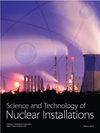聚变放射性废物管理风险识别与评估框架的初步研究
IF 0.9
4区 工程技术
Q3 NUCLEAR SCIENCE & TECHNOLOGY
引用次数: 1
摘要
与其他核能系统相比,聚变反应堆预计更安全、更环保,核扩散风险更低。然而,人们普遍认为,聚变反应堆将产生大量放射性物质。因此,与现有核能系统相比,充分了解聚变放射性废物(放射性废物)的总体辐射风险水平很重要。目前,对聚变放射性废物处理的研究主要集中在三个最终选择上:清除、回收和通过对聚变反应堆运行和退役产生的放射性物质进行活化评估进行处置。然而,对聚变放射性废物管理中的辐射风险,特别是在最终处置中的风险,很少进行研究。本文通过对聚变放射性废物与ITER和裂变反应堆(如压水堆、压水堆)的比较分析,试图探讨在当前可行的工业技术的前提下,如何确定聚变放射性废物管理过程中的辐射风险。在此基础上,提出了在正常退化和外部事件下处置库的风险评估框架。本文章由计算机程序翻译,如有差异,请以英文原文为准。
Preliminary Study on Risk Identification and Assessment Framework for Fusion Radioactive Waste Management
Fusion reactors are expected to be safer, more environmentally friendly, and to have a lower nuclear proliferation risk, compared with other nuclear energy systems. However, it is widely recognized that a large amount of radioactive materials will be produced by a fusion reactor. Therefore, it is important to fully understand the overall radiation risk level of fusion radioactive wastes (radwaste) compared with existing nuclear energy systems. Studies on the treatment of the fusion radwaste have been currently focused on three ultimate options: clearance, recycling, and disposal by activation assessment of radioactive materials from the operation and decommissioning of fusion reactors. However, the radiation risk in the management of fusion radwaste, especially in the final disposal, was seldom studied. Based on the comparative analysis of fusion radioactive waste with ITER and fission reactors (e.g., pressurized water reactor, PWR), this paper tries to discuss how to determine the radiation risk in the process of fusion radwaste management on the premise of the current feasible industrial technology. On this basis, a risk assessment framework for repository disposal under normal degradation and external events is proposed.
求助全文
通过发布文献求助,成功后即可免费获取论文全文。
去求助
来源期刊

Science and Technology of Nuclear Installations
NUCLEAR SCIENCE & TECHNOLOGY-
CiteScore
2.30
自引率
9.10%
发文量
51
审稿时长
4-8 weeks
期刊介绍:
Science and Technology of Nuclear Installations is an international scientific journal that aims to make available knowledge on issues related to the nuclear industry and to promote development in the area of nuclear sciences and technologies. The endeavor associated with the establishment and the growth of the journal is expected to lend support to the renaissance of nuclear technology in the world and especially in those countries where nuclear programs have not yet been developed.
 求助内容:
求助内容: 应助结果提醒方式:
应助结果提醒方式:


